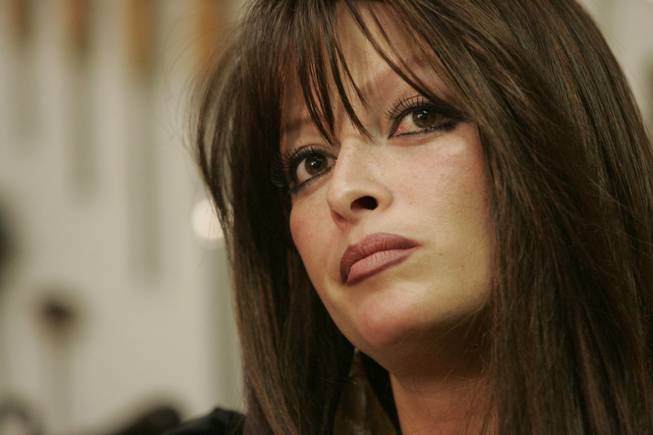
In addition to Gov. Jim Gibbons, Chrissy Mazzeo has sued Metro Police and former Clark County Sheriff Bill Young, alleging a cover-up of the governor’s alleged assault of the then-cocktail waitress.
Monday, Oct. 27, 2008 | 2 a.m.
Related Documents
The most intriguing — and important — aspect of Chrissy Mazzeo’s civil rights lawsuit against Gov. Jim Gibbons isn’t what it alleges happened between the two on the night of Oct. 13, 2006, but rather its allegations that the then-sheriff, his officers and the governor’s powerful political allies tried to cover up what happened.
The Metro Police investigation that cleared Gibbons of assaulting Mazzeo outside a Las Vegas restaurant will draw independent legal scrutiny for the first time, if the lawsuit plays out in federal court.
Sylvia Lazos, a UNLV law professor who specializes in civil rights litigation, said the 34-year-old former cocktail waitress has a tough — but not impossible — task of proving that a cover-up took place.
“The courts don’t make it easy for you to win this kind of case,” Lazos said. “But she’ll have traction in court because there are reasons to be concerned about what happened here. From what’s been reported, it looks like she definitely wasn’t treated like any other person trying to file a complaint with police.”
Allen Lichtenstein, general counsel for the American Civil Liberties Union of Nevada, said Mazzeo should get a “full and transparent analysis of what happened” if the legal process works the way it’s supposed to work.
Her attorney, Robert Kossack, is confident that will happen.
“If it weren’t for the civil rights violations, this case would have been investigated in the normal fashion,” said Kossack, who is no stranger to suing police. “Gibbons would have been arrested that night, and he wouldn’t have had access to the evidence until he was arraigned.”
Kossack alleges in the 33-page suit that Mazzeo’s 14th Amendment due process and equal protection rights were violated in a cover-up conspiracy from the moment she was interviewed by police following the alleged assault in a parking garage across the street from McCormick & Schmick’s restaurant. Gibbons was in the heat of his campaign for governor at the time, with the election just 25 days away.
The cover-up claims have lingered since then primarily because of the close relationship between some of the high-powered parties connected to the investigation — former Sheriff Bill Young, who oversaw the probe, political strategist Sig Rogich, who ran the governor’s campaign, and attorney Don Campbell, who represented Gibbons. Rogich, who also was Young’s top political strategist, had hired Campbell, who was also Young’s lawyer and longtime friend. All three men, along with Metro Police and Mazzeo’s ex-friend Pennie Mossett-Puhek, are named as defendants in the lawsuit.
Kossack acknowledged he hasn’t uncovered any new evidence pointing to a cover-up, and he makes some serious claims in the suit that he hasn’t substantiated, such as accusing Young and Campbell of conspiring to destroy the original surveillance videotapes that should have shown the late-night encounter between Mazzeo and Gibbons.
But Kossack also said that as a result of the media coverage of the lawsuit he has received new leads to pursue. Kossack is using a Web site to solicit information and donations for what could be an expensive legal fight.
One thing in Kossack’s favor is that the burden of proof in civil cases is much lighter than in criminal cases. You need only a preponderance of the evidence to win, as opposed to the standard of beyond a reasonable doubt. If the suit is allowed to proceed, Kossack also will be able to try to ferret out evidence before trial in sworn depositions of witnesses.
Still, a seasoned lawyer who regularly handles civil rights lawsuits described the lawsuit as a “gutsy move” by Kossack, adding “he’s likely to be taking on more than he can handle.”
That’s a reference to the influence and prestige of the defendants, all of whom have strongly denied participating in any cover-up, but have been reluctant to comment publicly on the allegations in the suit. Gibbons, now in the middle of a bitter divorce, is the highest elected official in the state, and Young, Rogich and Campbell all have solid reputations. All four men, along with the police department, have access to plenty of resources to defend themselves in court.
Nevertheless, Kossack contends that “Young kept Rogich and Gibbons informed of the investigation’s progress and released to them the information the police gathered as quickly as it was coming in.”
For Kossack, the cover-up began the night of the encounter between Mazzeo and Gibbons when, Kossack alleges, Rogich discussed it with Young and instructed Mossett-Puhek to discourage Mazzeo from stepping forward. Mazzeo alleges Mossett-Puhek conveyed physical threats to her.
Young has denied talking to Rogich that night, saying he didn’t learn of the investigation until the next morning because he was in Boston attending a police chiefs conference.
But Young admitted in an interview with the Sun a week after the encounter that he had telephoned Gibbons that morning to inform him of the criminal assault investigation. Young said he told Gibbons about Mazzeo’s allegations and arranged for detectives to interview Gibbons at his hotel room that afternoon.
Legal experts at the time criticized Young for tipping off Gibbons and not sending detectives to bang on his hotel room door hours earlier, before Gibbons had a chance to think about his story. Suspects in criminal assault cases usually aren’t afforded that much lead time. In that same Sun interview, Young also said he intended to vote for Gibbons in the upcoming election for governor, a comment critics charged contributed to the belief Mazzeo was being treated differently.
Young also told the Sun he hadn’t talked to Rogich about the investigation until a couple of days after detectives had interviewed Gibbons.
But a Sun analysis of Rogich’s cell phone records obtained by the district attorney’s office showed the political consultant had called Young nearly two dozen times from the day of the governor’s interview until the day of his second interview, Nov. 10, 2006. Some of the calls were listed as one minute, indicating they went to Young’s voice mail. Police would not release Young’s cell phone records, and no records of local calls over land lines between the two men were obtained by the district attorney.
Then, there was the purported effort to smear Mazzeo’s reputation and the saga over the parking garage surveillance tapes that at first existed, then didn’t exist, and two weeks later showed up without any sign of Mazzeo and Gibbons on them.
If the case does get into court — and that’s still a big if at this point — there’s plenty that could be combed through, as records previously withheld or not obtained by police are subpoenaed and both new and old witnesses, including the detectives who investigated the criminal case, are grilled in depositions.


Join the Discussion:
Check this out for a full explanation of our conversion to the LiveFyre commenting system and instructions on how to sign up for an account.
Full comments policy